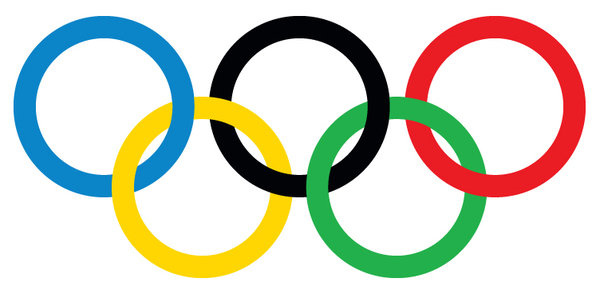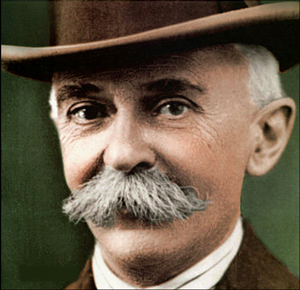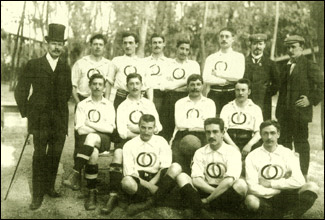Today, the entire world watched (or will watch on their DVRs later) as the torch lit the Olympic flame and the 2014 Winter Olympic games in Sochi, Russia officially commenced. And, for the next couple of weeks we'll be seeing those 5 interlaced rings everywhere. On everything. But where did the logo design for the Olympic rings come from, anyway?

There's a lot of mystery and misinformation on the internet about the logo's history, but the rings were actually created in 1913 by Baron Pierre de Coubertin. The Olympic games had already been reinstituted in 1896 in Athens, Greece, but it wasn't until the 1912 Olympic games in Stockholm, Sweden that all five continents were represented at the games. (I know what you're thinking, smarty pants, "Wait a minute! There are seven continents, not five!" This is true. But they didn't count the frozen and uninhabited continent of Antarctica, and apparently Americans are the only ones to separate North and South America into two different continents. Don't ask me why! Ask Pierre de Coubertin.) The next year Coubertin sent a letter with a sketch of the Olympic rings hand-colored at the top. The logo design was born!
 Baron Pierre de Coubertin: The Real Lord of the Rings. If growing awesome mustaches were an Olympic sport, we'd give Pierre de Coubertin a gold medal.
Baron Pierre de Coubertin: The Real Lord of the Rings. If growing awesome mustaches were an Olympic sport, we'd give Pierre de Coubertin a gold medal.
Coubertin wrote:
 So, each ring represents a continent (sorry Antarctica—you have apparently gone the way of Pluto according to the Olympic committee) and the colors are supposed to be representative of all the colors used in all the flags in the world. Pretty hefty symbolism for such a simple design, huh? There was a misconception that each color was supposed to represent a continent—probably because prior to 1951 the International Olympic Committee listed the colors as: blue for Europe, yellow for Asia, black for Africa, green for Australia, and red for the Americas. But that has since then been disproven, and the official statement is that the colors represent the flags of the world.
So, each ring represents a continent (sorry Antarctica—you have apparently gone the way of Pluto according to the Olympic committee) and the colors are supposed to be representative of all the colors used in all the flags in the world. Pretty hefty symbolism for such a simple design, huh? There was a misconception that each color was supposed to represent a continent—probably because prior to 1951 the International Olympic Committee listed the colors as: blue for Europe, yellow for Asia, black for Africa, green for Australia, and red for the Americas. But that has since then been disproven, and the official statement is that the colors represent the flags of the world.
Another misconception is that the rings spring from ancient Greek symbolism. According to an article in the New York Times, in 1984 a historian of Greek culture (and specifically the Olympics) discovered Olympic rings carved into some stone while bending over to tie his shoe on an archaeological dig in Delphi. Unfortunately for him, the rings were phony and had already fooled historians in the 1950s. The rings had actually been carved there during the 1936 Olympics by filmmakers as the torch was being carried through Greece—well after Coubertin's first design in 1913. The only potential ties to ancient Greece the rings have, are their resemblance to woven laurel wreaths victors would wear after the Olympic games.
The rings probably actually came from a design for the Union des Sociétés Françaises des Sports Athlétiques (USFSA), a sporting group founded in the late 1880s that Coubertin was the secretary-general of. The athlete's uniforms had two intertwined rings, representing the two separate athletic groups that had joined together to create USFSA.

Why doesn't anyone bring top hats and canes to sporting events anymore? I say we bring it back. Here's a picture of members of USFSA around 1900, thirteen years before Coubertin created the Olympic logo.
According to historian Karl Lennartz, Coubertin was most likely inspired to design the Olympic rings after seeing an ad for Dunlop-Pneumatic bicycle tires. The ad featured four cherubs holding up intertwining bike tires representing America, Africa, Asia, and Europe. The cherubic bike advertisement was being circulated in magazines in 1896—the same year as the first modern Olympic games in Athens—so it's possible that Coubertin saw it and was inspired.
However Coubertin was inspired to create the Olympic rings, the symbol has lasted for over 100 years now, and that's pretty amazing! As Coubertin said himself:
"These five rings represent the five parts of the world now won over to Olympism, ready to
accept its fruitful rivalries. In addition, the six colours combined in this way reproduce the colours of every country without exception. The blue and yellow of Sweden, the blue
and white of Greece, the tricolor flags of France, England, the United States, Germany, Belgium, Italy and Hungary, and the yellow and red of Spain are included, as are the innovative flags of Brazil and Australia, and those of ancient Japan and modern China. This, truly, is an international emblem."
Sources:
The New York Times, "The Origin of the Olympic Rings" by Daven Hiskey, "The Story of the Rings" by Karl Lennartz, The Olympic Museum



Leave a Reply